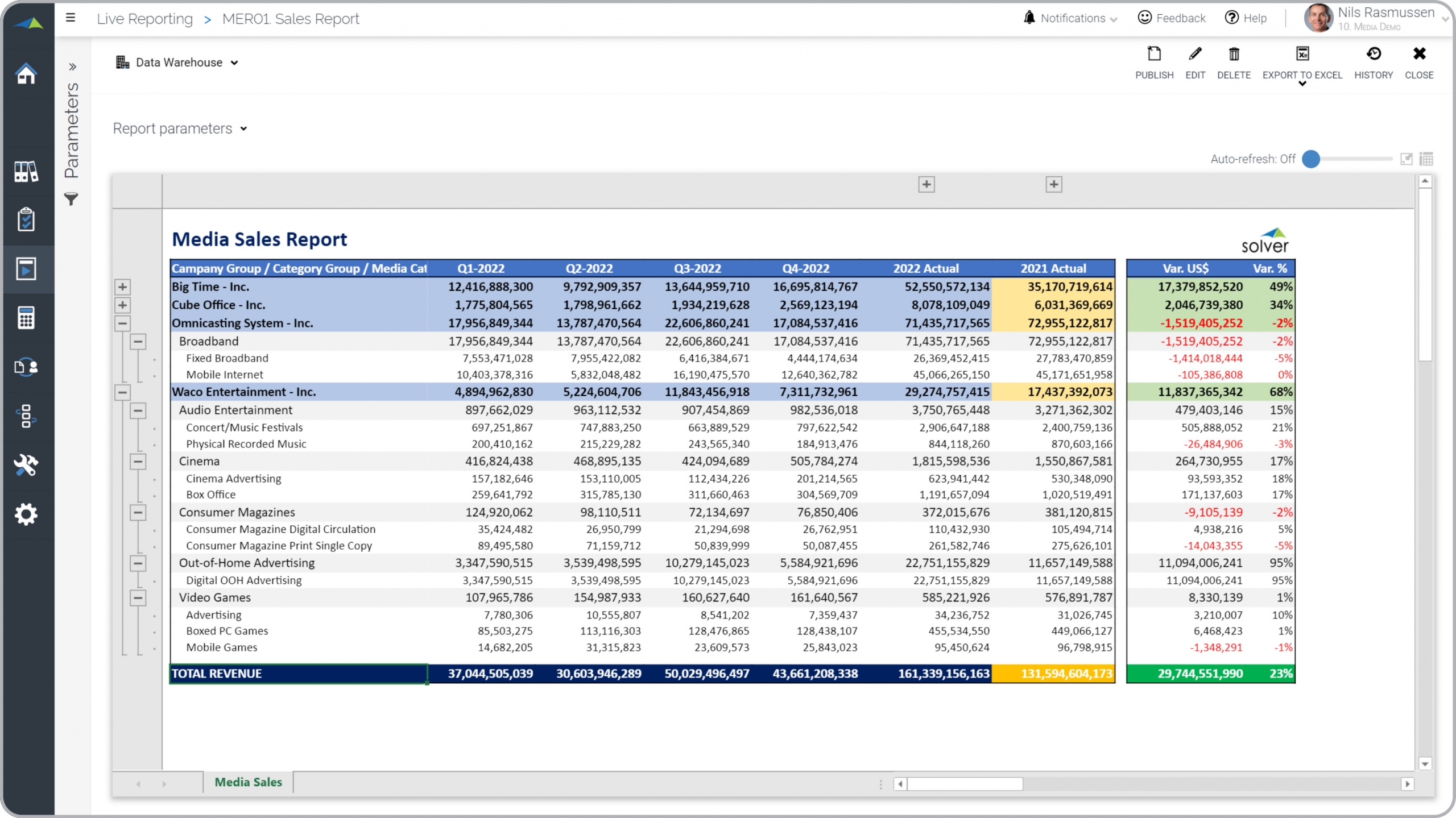Sales Report for Media Companies
What is
a
Sales Report for Media Companies
? Media Sales Reports are considered revenue analysis tools and are used by sales executives to analyze revenues across categories and subsidiaries/locations. Some of the main functionality in this type of report is that it shows sales by category, category group and company for any chosen period. Columns in the report include: The last four quarters with a total, total sales last year, variance amount and variance in percent. Each media category has sub-totals and everything is summarized to a grand total. You find an example of this type of report below.
Purpose of
Consolidated Media Sales Reports Media companies use Consolidated Media Sales Reports to get a clear picture of quarterly performance as well as revenue growth compared to prior year. When used as part of good business practices in Sales and Financial Planning & Analysis (FP&A) departments, a company can improve its marketing and sales strategies, and it can reduce the chances that managers make slow or no decisions due to lack of clear sales data.
Example of a
Consolidated Media Sales Report Here is an example of a Media Sales Report with details across categories and subsidiaries. [caption id="" align="alignnone" width="2560"]
 Example of a Sales Report for Media Companies[/caption] You can find hundreds of additional examples
here
Who Uses This Type of
Report
? The typical users of this type of report are: Executives, VP of Sales, Sales Managers, Budget Managers.
Other Reports Often Used in Conjunction with
Consolidated Media Sales Reports Progressive Sales and Financial Planning & Analysis (FP&A) departments sometimes use several different Consolidated Media Sales Reports, along with sales dashboards, sales forecasts, profit & loss reports, annual budgets, financial dashboards, KPI dashboards and other management and control tools.
Where Does the Data for Analysis Originate From? The Actual (historical transactions) data typically comes from enterprise resource planning (ERP) systems like: Microsoft Dynamics 365 (D365) Finance, Microsoft Dynamics 365 Business Central (D365 BC), Microsoft Dynamics AX, Microsoft Dynamics NAV, Microsoft Dynamics GP, Microsoft Dynamics SL, Sage Intacct, Sage 100, Sage 300, Sage 500, Sage X3, SAP Business One, SAP ByDesign, Acumatica, Netsuite and others. In analyses where budgets or forecasts are used, the planning data most often originates from in-house Excel spreadsheet models or from professional corporate performance management (CPM/EPM) solutions.
What Tools are Typically used for Reporting, Planning and Dashboards? Examples of business software used with the data and ERPs mentioned above are:
Example of a Sales Report for Media Companies[/caption] You can find hundreds of additional examples
here
Who Uses This Type of
Report
? The typical users of this type of report are: Executives, VP of Sales, Sales Managers, Budget Managers.
Other Reports Often Used in Conjunction with
Consolidated Media Sales Reports Progressive Sales and Financial Planning & Analysis (FP&A) departments sometimes use several different Consolidated Media Sales Reports, along with sales dashboards, sales forecasts, profit & loss reports, annual budgets, financial dashboards, KPI dashboards and other management and control tools.
Where Does the Data for Analysis Originate From? The Actual (historical transactions) data typically comes from enterprise resource planning (ERP) systems like: Microsoft Dynamics 365 (D365) Finance, Microsoft Dynamics 365 Business Central (D365 BC), Microsoft Dynamics AX, Microsoft Dynamics NAV, Microsoft Dynamics GP, Microsoft Dynamics SL, Sage Intacct, Sage 100, Sage 300, Sage 500, Sage X3, SAP Business One, SAP ByDesign, Acumatica, Netsuite and others. In analyses where budgets or forecasts are used, the planning data most often originates from in-house Excel spreadsheet models or from professional corporate performance management (CPM/EPM) solutions.
What Tools are Typically used for Reporting, Planning and Dashboards? Examples of business software used with the data and ERPs mentioned above are:
- Native ERP report writers and query tools
- Spreadsheets (for example Microsoft Excel)
- Corporate Performance Management (CPM) tools (for example Solver)
- Dashboards (for example Microsoft Power BI and Tableau)
Corporate Performance Management (CPM) Cloud Solutions and More Examples
July 22, 2021
TAGS:
Reporting,
Solver,
print,
report writer,
Microsoft,
template,
practice,
Acumatica,
Netsuite,
TV,
streaming,
Finance,
planning,
GP,
category,
Business Central,
excel,
radio,
ax,
sales analysis,
forecast,
Budget,
media sales report,
Dynamics 365,
budgeting,
Cloud,
Software,
consolidated sales,
Tableau,
SAP,
example,
media,
best,
quarterly sales,
Sage,
BC,
D365,
NAV,
Intacct,
broadcast,
brand,
online,
CPM,
report,
SL,
Management,
dynamics,
monthly sales,
Power BI

